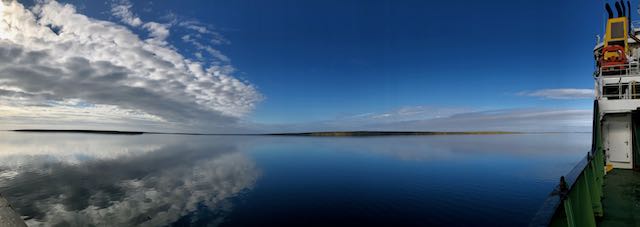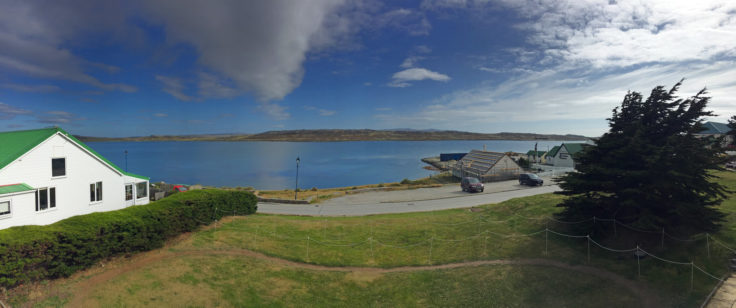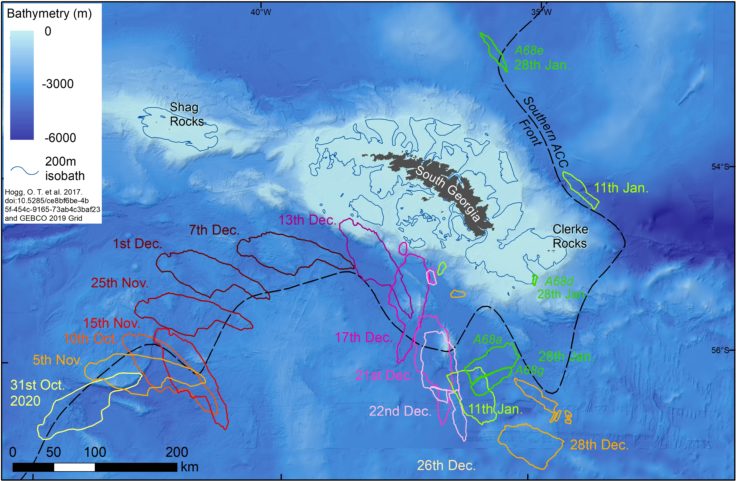Blog: Mission to investigate A68a iceberg
25 January, 2021
Preparations are underway: a team of researchers are quarantining in the Falkland Islands before they begin their mission on board RRS James Cook bound for the giant A68a iceberg.
The research expedition aims to observe the Southern Ocean in the Drake Passage and to determine the impact of the iceberg on the South Georgia wildlife population. Oceanographers Dr Yvonne Firing from National Oceanography Centre (NOC) and Dr Povl Abrahamsen from British Antarctic Survey (BAS) describe their experiences of pre-mission quarantine below.
Alongside in Mare Harbour, Dr Yvonne Firing
We flew south from Brize Norton to Mount Pleasant, Falkland Islands on 10 January, and the NOC contingent went directly to the ship to start our 14-day quarantine on board RRS James Cook.

In most years we arrive at the ship only a few days before sailing, so preparing our equipment and computers is a sprint, and unpacking in our cabins is left to the last minute. This year we had several days just to arrange (and rearrange) our cabins while waiting for results from post-arrival COVID tests so that we could start mobilisation.
Since then we have been busy! After several days of mobilisation we have commissioned the meteorological sensors, the CTD that measures temperature, salinity, dissolved oxygen and other properties throughout the water column, the equipment for analysing water samples to calibrate these measurements, the mooring winches, and the data-processing workstation have been set up. The mooring gear itself, the gliders, and some filtration equipment are waiting for the arrival of the British Antarctic Survey cohort next week, while some instruments, like the acoustic sensors, won’t be started up until we are at sea.
We’ve adjusted pretty quickly to working around each other to prepare equipment in the ship labs while keeping a distance, and discussing plans while speaking through face coverings. Then there’s the novelty of just seeing and speaking to people, no screens involved, every day!
Notes from Port Stanley, Dr Povl Abrahamsen
While the NOC scientists, technicians, and crew are quarantined on the ship in Mare Harbour, the small BAS contingent for the cruise is quarantined ashore in Stanley, along with a few other BAS staff on their way to the stations in South Georgia and Antarctica.
Stanley is the capital of the Falkland Islands, and is located in Port Stanley or Stanley Harbour, an amazing natural harbour, which has provided shelter to passing ships for centuries. I was lucky to get a room facing the sea, so when I’m not working or enjoying the fresh air I can watch the geese chase each other, and have even seen a dolphin and a few seals swimming between the kelp.

We are confined to our rooms most of the day, apart from going out individually for fresh air and exercise for two half-hour time slots. We do try to keep in touch with what is happening on board, but are still feeling a little bit cut off from the ship. We certainly look forward to joining the rest of the team once our 14-day quarantine finishes this week!
–
Full blogs and future updates can be viewed at the project website here and we will continue to follow progress on the British Antarctic Survey website and social media channels (Twitter, Facebook, LinkedIn, Instagram)
–
